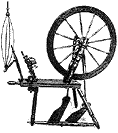
|
Welcome
to the website of |
 |
|
|
Textiles in Nepal by Karin Barton |
|
January might not seem the best time to visit this amazing country but, for us, it proved to be an excellent season; dry, sunny, warm, not too many tourists and therefore space to see and look.
ACP has about 850 members, both full-time and part-time, earning between £200 and £2000 per annum and making an amazing range of things from copper to cotton and woollen textiles, wood, paper and pottery. Ms Meera Bhattari, one of the founders, and for 14 years the executive director, is justly proud of the income generated for women and the very high standard of work and design. She also places great emphasis on environmental improvement, from picking up sweet papers, to cleaning waste water. |
|
| We spent a morning in nearby Kirtipur, a traditional centre for weaving, where looms have been handed down through the generations. Laxmi Maharjan is the leader of a group of 60. She specialises and has invested in the equipment necessary for making warps. Once ready the warp beams are delivered to the weavers to set in their looms preparatory to threading up. We saw both 2 and 4 shaft looms and plain, check, and double-faced cloth. I was particularly attracted to a black plain weave shot with red which did not look like cotton at all but was so beautiful it looked like taffeta. |
| We spent a morning in nearby Kirtipur, a traditional centre for weaving, where looms have been handed down through the generations. Laxmi Maharjan is the leader of a group of 60. She specialises and has invested in the equipment necessary for making warps. Once ready the warp beams are delivered to the weavers to set in their looms preparatory to threading up. We saw both 2 and 4 shaft looms and plain, check, and double-faced cloth. I was particularly attracted to a black plain weave shot with red which did not look like cotton at all but was so beautiful it looked like taffeta. |
| The local Turu people are skilled at applique and this work is now incorporated into quilts, wall hangings, cushion covers and all kinds of ingenious children’s garments and toys, many enhanced with bells. We met seven ladies at their work, one arranging pieces on the floor while the other six did the machining, and the leader of the group also managed to keep an eye on her elderly parents. |
|
We watched the making of felt. This was hardened by hand rolling and also rolled with the feet. The wool, in grey and many colours, came from Australia and New Zealand. Generally, the methods used were traditional but we saw that they were also experimenting with Nuno felt. The willingness to try new methods, designs, techniques and colour schemes is typical of the forward approach encouraged by Ms Bhattari. Since exports are made to fifteen separate countries it is important to be aware of what will sell in each of them, and the appropriate range of sizes. While we were there floor cushions were being made for Japan, bathmats for Italy, and knitwear for the USA. New ranges were being prepared for next Christmas.
|
|
E-mail [email protected]
We stayed at a very nice guest house, E-mail: [email protected]